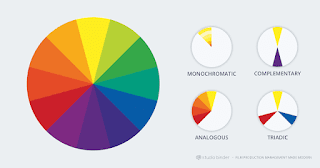- A well designed movie color palette evokes mood and sets the tone for the film.
Hue – the color itself.Saturation – intensity of the color.Value – The darkness or lightness of a colorChoosing the right colors for the right spots can create emotions our audience .For example A strong red color has been shown to raise blood pressure, while a blue color elicits a calming effect.Color theory norms should be understood by filmmakers, but never seen as a limitation.The types of movie Color palettes /Color Schemes
There are a few different movie color palette. A balanced movie color palette and scheme refers to the harmonious relationships of colors on a color wheel.
Analogous color schemes utilize colors that are next to one another on the complementary color wheel. They tend to occur in nature and create a harmonious feeling that is pleasing to the eye.Since the colors lack the contrast and tension of the complementary colors, they instead create a kind of visual unity.
TRIADIC COLOR SCHEMES : A triadic color scheme is when three colors that are evenly spaced around the complementary color wheel are used in conjunction.One color in the triadic colors scheme is chosen to be the dominant one with other two used in complementary fashion. Triadic color schemes are somewhat less common.
























